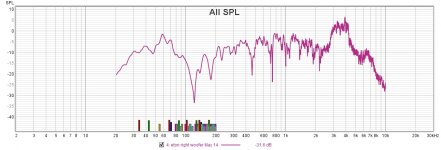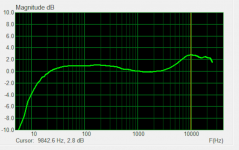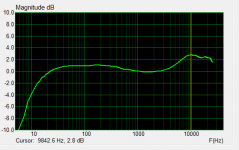Thanks for the encouragement! I think I needed it...
I do have a few nice mics that are pretty flat from 20-20khz, and an Audient iD44 interface. Plus a few rigid fiberglass sound absorbers...
Good news is I have been involved with recording and mixing for 30+ years now. so I do have experience with operating mics.
Budget is kinda tight right now, do you think I could use my Blue Reactor mic? I know how to trace the SPL of the mic and insert it into REW. it has a bump around 10khz, and rolls off around 45hz...
I also have a small diaphragm condenser mic that is flat from 30hz to 18khz..
Thanks or the help, and I will keep you posted!
I do have a few nice mics that are pretty flat from 20-20khz, and an Audient iD44 interface. Plus a few rigid fiberglass sound absorbers...
Good news is I have been involved with recording and mixing for 30+ years now. so I do have experience with operating mics.
Budget is kinda tight right now, do you think I could use my Blue Reactor mic? I know how to trace the SPL of the mic and insert it into REW. it has a bump around 10khz, and rolls off around 45hz...
I also have a small diaphragm condenser mic that is flat from 30hz to 18khz..
Thanks or the help, and I will keep you posted!
Hey everyone!
I did my first measurements on the drivers...
I used REW, Audient id44 interface, Octava MK012 mic. Measured at 1m
no crossover, just straight to the amp.
I calibrated the sound card too.
I ran a sweep on the right speaker and here is what I got:

Huge dip at 120hz and over all poor response.
I tried using a different amplifier, and same result
So I tried the left woofer to see if maybe the right one was damaged or something and here is the left speaker(I forgot to rename the speaker on the bottom of the pic, please disregard) :

still poor result, and same dip at 120hz....
I can hear the speaker get quieter at that range too, it, so it's not a mic issue.
Hmm, what am I messing up?
Any ideas?
Man I am going to be making a bunch of chocolate cake I feel!
Thanks!
I did my first measurements on the drivers...
I used REW, Audient id44 interface, Octava MK012 mic. Measured at 1m
no crossover, just straight to the amp.
I calibrated the sound card too.
I ran a sweep on the right speaker and here is what I got:

Huge dip at 120hz and over all poor response.
I tried using a different amplifier, and same result
So I tried the left woofer to see if maybe the right one was damaged or something and here is the left speaker(I forgot to rename the speaker on the bottom of the pic, please disregard) :

still poor result, and same dip at 120hz....
I can hear the speaker get quieter at that range too, it, so it's not a mic issue.
Hmm, what am I messing up?
Any ideas?
Man I am going to be making a bunch of chocolate cake I feel!
Thanks!
Last edited:
Before you make any acoustic loudspeaker measurements, it is good practice to first check whether sound card itself (loopback) proves to be flat, then sound card + amplifier, bearing in mind to not overload the sound card input with too great a voltage (0.5 Vrms at 1 khz sine wave is enough) measured at amp output. Any eq or sound effects are normally turned off.
And your microphone is of cardiod characteristic. Meaurement mics are omnidirectional.
Can you be more specific where exactly did you place microphone and what did the room you took measurement in look like. A room large enough to have 2m clearance from any obstacle or better is good.
Try measuring the woofer near field with mic very close to dust cap, 1 cm perhaps. Let the time window be large enough to capture bass, at least 20-30ms.
And your microphone is of cardiod characteristic. Meaurement mics are omnidirectional.
Can you be more specific where exactly did you place microphone and what did the room you took measurement in look like. A room large enough to have 2m clearance from any obstacle or better is good.
Try measuring the woofer near field with mic very close to dust cap, 1 cm perhaps. Let the time window be large enough to capture bass, at least 20-30ms.
I did check the sound card loopback, and it was nice and flat. I did not check the amplifier.
Both amps I tried had the same result with the woofer. Amp 1 is a Crown XLS1502. Amp 2 is a Crown XTi 1002.
I just measured the speakers in place, in a 10ftx14ft room, and the speakers are 2 feet from the walls on the sides and 4 inches on the backs.
I can hear with my ear the dip in volume when I generate a sinewave @120hz, it is quite easy to hear. I don't think it is reflections from the room.
BUT, what are the odds that both speakers have the same issue, with two different amps, and a pretty high end audio interface?
So there must be some issue in my setup I need to find...I just don't know what else to check.
I have a large diaphragm condenser mic that has a omni polar pattern, I will try close mic-ing it tomorrow. I don't know if it will help since I can actually hear the issue.
The woofers are probably not damaged, given that both have a similar response issue. What are the odds both speaker are damaged and have the same freq. response problem?
Well I hope it can be figured it out!
Thanks!
Both amps I tried had the same result with the woofer. Amp 1 is a Crown XLS1502. Amp 2 is a Crown XTi 1002.
I just measured the speakers in place, in a 10ftx14ft room, and the speakers are 2 feet from the walls on the sides and 4 inches on the backs.
I can hear with my ear the dip in volume when I generate a sinewave @120hz, it is quite easy to hear. I don't think it is reflections from the room.
BUT, what are the odds that both speakers have the same issue, with two different amps, and a pretty high end audio interface?
So there must be some issue in my setup I need to find...I just don't know what else to check.
I have a large diaphragm condenser mic that has a omni polar pattern, I will try close mic-ing it tomorrow. I don't know if it will help since I can actually hear the issue.
The woofers are probably not damaged, given that both have a similar response issue. What are the odds both speaker are damaged and have the same freq. response problem?
Well I hope it can be figured it out!
Thanks!
Hmm, what am I messing up?
This is probably not as bad as you think.
The dip around 100hz is probably just the room. "Wall dip" and/or room modes. You may need to move the speakers and or listening position around to get rid of that. This is a good reason to have separate satellite and subs, so the subs can be moved to an optimal location.
The high frequency roll off is probably the microphone. Are you using the mic 90 deg to the speaker?
That big fat bump at 3-4khz? Could be the mic, could be the speaker, probably not the room. This is why it's important to have a calibrated mic.
If you make gated measurements (emphasis on gated) with a calibrated mic, you are eliminating the room and your microphone from the equation, and you know exactly what your speaker is doing. Here is a guide on making gated measurements with REW
Loudspeaker measurements
As for the mic, the advertised frequency response may or may not be accurate, or the quality control may or may not be great. No way of knowing without calibration. Behringer advertises ruler flat frequency response for the ECM8000:
An externally hosted image should be here but it was not working when we last tested it.
Cross spectrum measured 85 of them and this is what they saw:
An externally hosted image should be here but it was not working when we last tested it.
Another thing you can do to investigate is measure with only one driver connected at a time so you can see what your crossover is doing.
Alrighty,
I just purchased the above measurement mic (Behringer ECM8000)!
Should be getting it later this week!
Is there a good tutorial of how to set up the above mentioned gate in REW?
Or just a overall good tutorial video of using REW to measure speakers for a crossover? Is there something about removing the impulse response too?
Thanks!
I just purchased the above measurement mic (Behringer ECM8000)!
Should be getting it later this week!
Is there a good tutorial of how to set up the above mentioned gate in REW?
Or just a overall good tutorial video of using REW to measure speakers for a crossover? Is there something about removing the impulse response too?
Thanks!
Oh yeah, just wanted to let you know that my above measurements were just the woofers hooked up in the cabinet, no mid or tweet, or subwoofer for that matter....
Whoops I see that you said WITH the crossover...so...nevermind....
Whoops I see that you said WITH the crossover...so...nevermind....
Last edited:
,
I just purchased the above measurement mic (Behringer ECM8000)!
Thanks!
Oh no! My post meant to illustrate how much variation there is in cheap mics, and why it is important to get a calibrated one (ie one with a calibration file). The only place I know the get a cheap mic with a good calibration file is cross spectrum labs. Kim Girardin used to calibrate mics but I don't think he does it anymore. You can see from the graph above there is about 5 db typical variation in the ecm8000 at 10khz, which is not good.
I would try to cancel/return the behringer and get a dayton EMM6 for $75 from cross spectrum labs. It's only slightly more expensive than buying from parts express, but it comes with an accurate calibration file made by cross spectrum, which is worth the extra money many many many times over. The factory calibration file that comes with the emm6 is garbage, I have verified this myself. Cross spectrum says the emm6 is out of stock as of 2019, I would just try to order it and see what happens. Otherwise get the UMIK1 from cross spectrum for $110.
Cross spectrum used to calibrate the Ecm8000 but switched to the emm6 because the ecm had declined in quality.
Above that price point I believe theyhe next cheapest "known" reliable mic is the earthworks m23 for $500.
Sorry for the trouble/confusion I have caused you.
Re room eq wizard, I haven't made a gated measurement with that software, but it should be trivial.
Your new crossover looks very well behaved, good work! My only suggestion would be to move the mid/tweeter crossover frequency down as a 5" mid is going to be beaming significantly at 3.5kHz.
For a 1" tweeter with 0.4mm one-way xmax I would guess you could push it down to 2.0-2.5kHz.
With 2.5dB change at various frequencies between the old and new crossover it'll certainly sound different! Whether or not this is subjectively 'better' is up to you as the change is going to mostly just be a difference in frequency response. I would keep an open mind as the upper mid / lower treble are going to initially sound very forward if you're used to listening to the old crossover.
I would not stress about the calibration of your microphone. I use the EMM6 with the factory calibration and the effects of baffle edge diffraction and room modes/reflections are far more severe than the effect of the mic calibration. If it's out then it's only out 1-2dB which is within a 'subjective preference' tolerance imo. To measure accurately below about 500Hz you're going to need to measure outside in a wide open area, and perform a ground plane measurement to capture the low frequencies without ground reflections causing deep nulls. The alternative is to place the mic very close to the cone to capture the low frequencies, but then your measurement is blind to the amount of baffle-step so you have to make an educated guess.
For a 1" tweeter with 0.4mm one-way xmax I would guess you could push it down to 2.0-2.5kHz.
With 2.5dB change at various frequencies between the old and new crossover it'll certainly sound different! Whether or not this is subjectively 'better' is up to you as the change is going to mostly just be a difference in frequency response. I would keep an open mind as the upper mid / lower treble are going to initially sound very forward if you're used to listening to the old crossover.
I would not stress about the calibration of your microphone. I use the EMM6 with the factory calibration and the effects of baffle edge diffraction and room modes/reflections are far more severe than the effect of the mic calibration. If it's out then it's only out 1-2dB which is within a 'subjective preference' tolerance imo. To measure accurately below about 500Hz you're going to need to measure outside in a wide open area, and perform a ground plane measurement to capture the low frequencies without ground reflections causing deep nulls. The alternative is to place the mic very close to the cone to capture the low frequencies, but then your measurement is blind to the amount of baffle-step so you have to make an educated guess.
Last edited:
TMM, you're right, calibration is not critical and the ECM is only $30. But I also think the extra $45 is a small price to pay for a microphone that is a known quantity. Also it's not 1-2db, its more like 2-7 for the ECM8000. Major Ninth can mitigate this by using the ECM8000 at a 90 degree angle to the speaker (eg pointed at ceiling). This should give flat frequency response on a typical ECM8000.
I have a couple of EMM6s, both are off about 3db off at 10khz, like this one:

I trust cross spectrum because my calibrated EMM6 is in very close agreement with an earthworks m23 I bought to compare.
Earthworks M23 and CSL EMM-6 measurement mic comparison
I have a couple of EMM6s, both are off about 3db off at 10khz, like this one:

I trust cross spectrum because my calibrated EMM6 is in very close agreement with an earthworks m23 I bought to compare.
Earthworks M23 and CSL EMM-6 measurement mic comparison
Attachments
I did edit my own post above, with the stated reason: Can't read correctly...So I guess I did it again and bought the wrong mic, lol....
I will make it work, I bought a mint condition used one for cheap, so no biggie...
And I will use the advice of pointing it toward the ceiling...
I will make it work, I bought a mint condition used one for cheap, so no biggie...
And I will use the advice of pointing it toward the ceiling...
Yes it's not a deal-breaker. You will still get a good speaker designing with the ECM and a generic calibration file. You might then further tweak the voicing of the higher than 5k region by ear. The thing is, you tend to do that regardless of the mic anyway.
This treads not dead! I was sick for a week with a 103+ temp. But I did do some measurements, I will post soon!
This is probably not as bad as you think.
The dip around 100hz is probably just the room. "Wall dip" and/or room modes. You may need to move the speakers and or listening position around to get rid of that. This is a good reason to have separate satellite and subs, so the subs can be moved to an optimal location.
.
Looks like a standing wave at 40Hz is causing the null at 120 Hz as it is the 3rd harmonic and the other dips look like they line up with higher order harmonics.
One way to do it is set the speaker on a bed facing out an open door about 3 feet from the door with no obstructions in the immediate area and set the mic on a stand just out side the door. A sliding glass door that opens out on to a second story deck works nicely especially if it has heavy curtains or drapes.
It is possible to self calibrate the ECM8000 if you have a tweeter with a known published measurement of the same tweeter in conditions you can replicate from something on line measured with a calibrated mic.
I was able to get very very close to my UMIK-1.
I was able to get very very close to my UMIK-1.
- Home
- Loudspeakers
- Multi-Way
- Eton 3-way crossover REDESIGN - need advice
